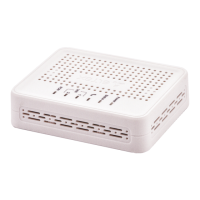____________________________________________________________________________________
____________________________________________________________________________________
46 NTU-2V, NTU-RG Optical Network Terminals
– OBSS Co-Existence – tolerance setting for the chosen mode (20 MHz or 40 MHz. When set to
Enable, chooses an optimal mode of operation taking into account the Bandwidth parameter; the
mode will depend only on the Bandwidth parameter otherwise;
– RX Chain Power Save – disables one of the device's antennas to save energy;
– RX Chain Power Save Quiet Time – time period during which the traffic intensity should be lower
than PPS for the power saving mode to be enabled;
– RX Chain Power Save PPS – the upper limit of PPS (packet per second). If the packets intensity of
the WLAN interface does not exceed this value during the time specified in RX Chain Power Save
Quiet Time, the power saving mode is turned on;
– 54g™ Rate – connection rate in the 54g™ compatibility mode;
– Multicast Rate – multicast traffic rate;
– Basic Rate – basic data rate;
– Fragmentation Threshold – fragmentation threshold in bytes. If a packet size exceeds the value,
the packet will be fragmented into parts of corresponding size;
– RTS Threshold – if a packet size is lower than the set RTS threshold value, the RTS/CTS mechanism
will not be used (channel connection using "ready to send"/"ready to receive" signals);
– DTIM Interval – time period after which broadcast and multicast packets in buffer will be delivered
to wireless clients;
– Beacon Interval – time period after which an information packet is sent to the wireless network to
confirm the access point is active;
– Global Max Clients – the maximum number of wireless clients;
– XPress™ Technology – allows increase of wireless throughput up to 27 % in 802.11g networks.
XPress™ Technology can increase the throughput up to 75 % in mixed networks (802.11g and
802.11b);
– Transmit Power – the transmit power of the access point;
– WMM (Wi-Fi Multimedia) – enables the Wi-Fi Multimedia (WMM) mode. The mode allows fast
and quality transmission of audio and video content simultaneously with data transmission;
– WMM No Acknowledgement – the receiving side does not acknowledge packets in this mode. This
increases transmission efficiency of low-interference medium, however decreases the efficiency of
high-interference one;
– WMM APSD – enables automatic switching to the power saving mode;
– Wireless Mode – the operating mode:
– Access Point – the access point operating mode;
– Wireless Ethernet – a mode supporting Wireless Ethernet for joining network segments;
– URE – uses the access point/router as a repeater. The mode is used to connect two wireless points
in case direct connection is not possible;
– URE Mode – the repeater mode selected (bridge (Range Extender), Routed (Travel Router));
– STA Retry Time (sec) – time period during which the access points tries to establish connection
with a Wi-Fi client.
Click the Apply/Save button to accept and save the changes.
4.6 The Storage Service Menu. File Storage Services
4.6.1 The Storage Device Info Submenu. Information on Connected Devices
The menu lists all available connected storage devices. The following information is provided:

